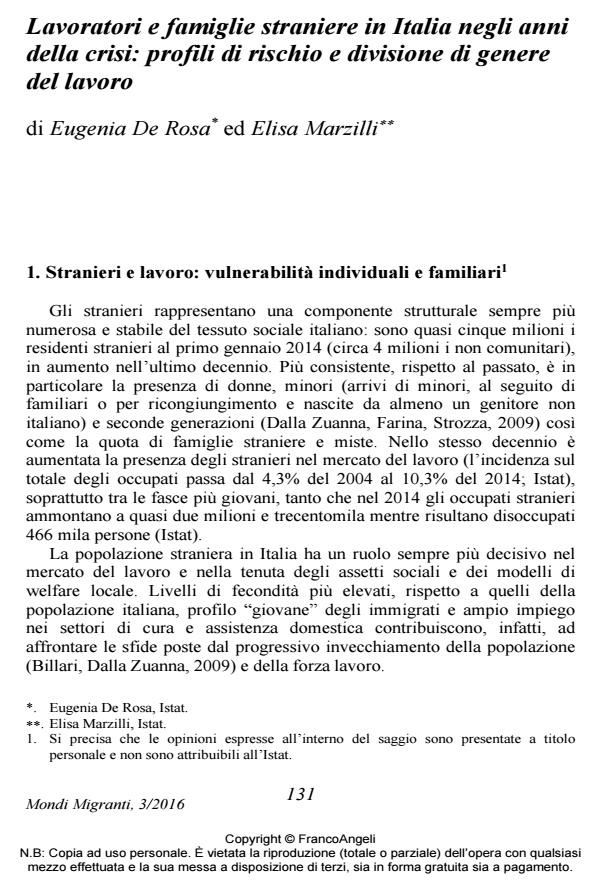Migrant workers and families in the Italian labour market during the crisis: profile of vulnerable workers and gender division of labour
Journal title MONDI MIGRANTI
Author/s Eugenia De Rosa, Elisa Marzilli
Publishing Year 2017 Issue 2016/3
Language Italian Pages 24 P. 131-154 File size 395 KB
DOI 10.3280/MM2016-003009
DOI is like a bar code for intellectual property: to have more infomation
click here
Below, you can see the article first page
If you want to buy this article in PDF format, you can do it, following the instructions to buy download credits

FrancoAngeli is member of Publishers International Linking Association, Inc (PILA), a not-for-profit association which run the CrossRef service enabling links to and from online scholarly content.
The economic crisis that began in 2008 has affected migrant workers, who are mainly younger and a weak segment in the Italian labor market due to being mainly employed in low-skilled jobs. The effects of the crisis affect levels of employment, unemployment and inactivity of migrants in Italy and also working conditions (employment instability, discontinuity of income and low pay), satisfaction levels, workers’ rights, employment security and more generally living conditions and well-being. The crisis is causing an impoverishment of migrant workers and families ("working poor") and the links between work, vulnerability and poverty are becoming clearer. Using data from the Labour Force Survey by Istat the aim of the paper is provide a detailed picture of migrant workers in the Italian labor market and more specifically to investigate the impact of the economic and financial crisis. The analysis is conducted combining two different analytical perspectives of analysis, individual and household, and adopting a gender-sensitive approach. The paper is structured as follows. The 1^ section gives an indication of the research questions to be addressed, the methods used and the contribution to the academic literature. The 2^ section investigates macro-level dynamics of the labor market comparing migrants and Italians (employed, unemployed and inactive). The 3^ section includes an analysis of the occupational structure (sectors and occupations) and quality of migrant jobs. The 4^ section makes a household analysis of the distribution of work within overseas families. In the 5^ section the gender distribution of paid work in migrant families is compared with that in Italian families, with a focus on couples. Finally, in the light of the individual and household profiles of vulnerable workers identified, the paper discusses areas of analysis still poorly explored.
Keywords: Migrants and migrant families, gender gap, gender division of labour, occupational (im)mobility.
Eugenia De Rosa, Elisa Marzilli, Lavoratori e famiglie straniere in Italia negli anni della crisi: profili di rischio e divisione di genere del lavoro in "MONDI MIGRANTI" 3/2016, pp 131-154, DOI: 10.3280/MM2016-003009